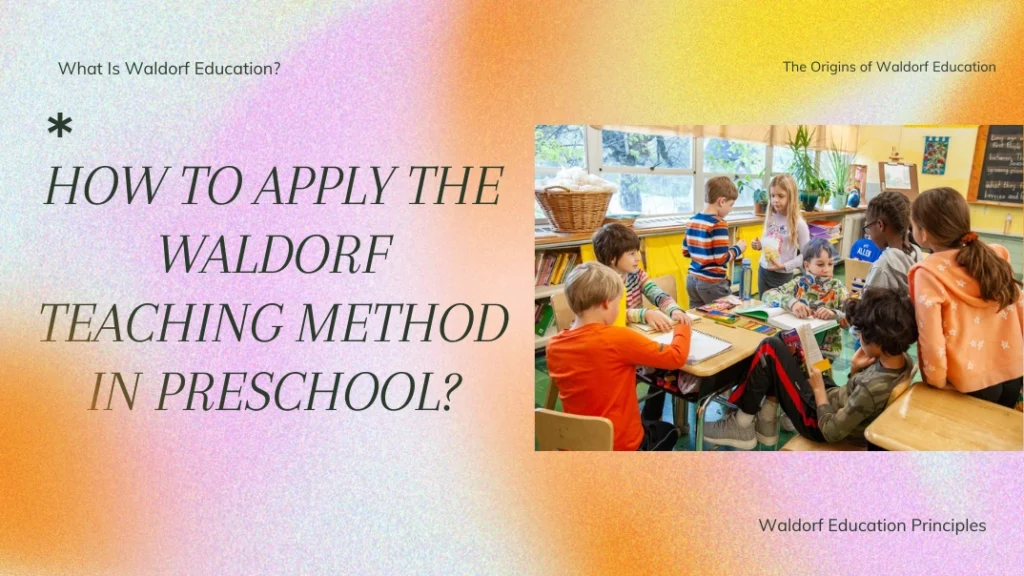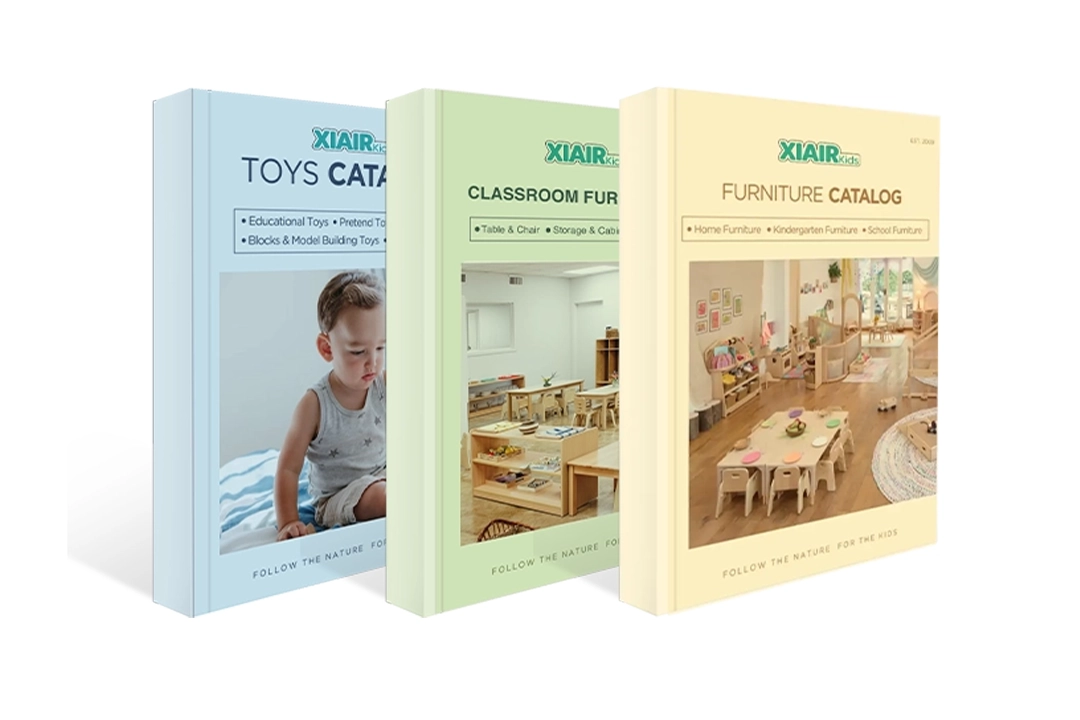Waldorf Öğretim Yöntemi, özellikle bütünsel çocuk gelişiminin önceliklendirildiği okul öncesi ortamlarda dünya çapında önemli bir ivme kazandı. Ancak tam olarak nedir? Waldorf eğitimive Waldorf müfredatı okul öncesi eğitim kurumlarında etkili bir şekilde nasıl uygulanabilir? Bu yöntem, çocuğun bütününü geliştirmeye odaklanması (zihin, beden ve ruh) ve yaratıcılığa, bağımsızlığa ve doğayla bağlantıya vurgu yapması nedeniyle öne çıkıyor. Bu makale, sizi Waldorf eğitiminin ilkeleri, artıları ve eksileri ve metodolojilerini sınıfınıza nasıl dahil edeceğiniz konusunda bilgilendirecektir.
Rudolf Steiner'ın eğitim felsefesinden kaynaklanan Waldorf Öğretim Yöntemi, deneyimsel öğrenmeye öncelik verir, yaratıcılığı ve doğayla derin bir ilişkiyi teşvik eder. Waldorf eğitimini okul öncesine dahil ederek, çocuklar akademik hazırlık alır ve yaratıcı düşünürler, sorumlu bireyler ve yaşam boyu öğrenenler olmaları için yetiştirilirler.
Waldorf Öğretim Yöntemi, çocukluk öğrenimine daha dengeli, bütünsel bir yaklaşım sağlayarak geleneksel eğitimden ayrılır. Waldorf pedagojisi aracılığıyla çocuklar akademik konuları, sanatları, pratik becerileri ve kişisel gelişimi kapsayan zengin bir öğrenme ortamı deneyimler. Ancak eğitimciler ve ebeveynler, Waldorf Öğretim Yöntemini uygulamanın temel ilkelerine bağlılık gerektirdiğini anlamalıdır.
Peki Waldorf Öğretim Yöntemi geleneksel modellerden nasıl farklılaşıyor ve erken çocukluk ortamlarına nasıl entegre edilebilir? Öncelikle Waldorf eğitiminin gerçekte ne olduğunu inceleyelim.
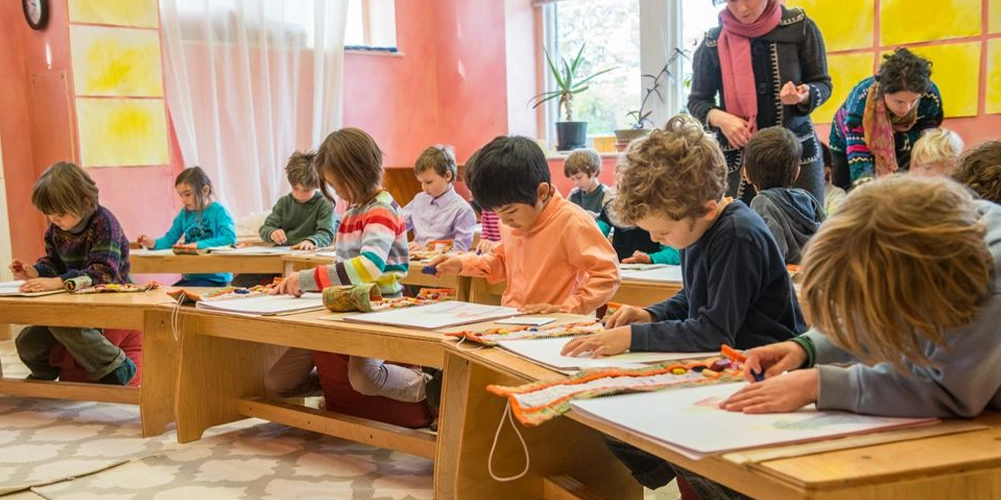
giriiş
Waldorf Öğretim Yöntemi, yaratıcı ve çocuk odaklı öğrenme yaklaşımıyla bilinir. Kökleri Rudolf Steiner'ın fikirlerine dayanan Waldorf eğitimi, dünya çapındaki okullarda ve anaokullarında uygulanmaktadır. Geleneksel sınıfların aksine, Waldorf okulları uygulamalı deneyimlere, güçlü bir ritim duygusuna ve doğayla yakın bir bağa değer verir. Bu benzersiz öğretim yöntemi, birçok ebeveyn ve öğretmeni her çocuğun doğal gelişimini ve öğrenme sevgisini desteklemenin yeni yollarını aramaya teşvik etmiştir. Aşağıdaki bölümlerde, Waldorf yaklaşımını bu kadar özel kılan temel fikir ve ilkeleri inceleyeceğiz.
Waldorf Öğretim Yöntemi: Temeller ve Temel İlkeler
Waldorf Öğretim Yöntemi, çocukların zihinleri, bedenleri ve duyguları birlikte desteklendiğinde en iyi şekilde öğrendiklerine inanır. Rudolf Steiner tarafından başlatılan bu yaklaşım, her çocuğun benzersiz olduğunu ve büyürken farklı aşamalardan geçtiğini kabul eder. Waldorf sınıflarında öğrenme, uygulamalı ve yaratıcıdır; oyun, sanat ve doğayı keşfetmeye bolca zaman ayrılır. Düzenli günlük ve mevsimsel bir ritim, çocukların kendilerini güvende hissetmelerine yardımcı olur. Öğretmenler her çocuğun hızına saygı duyar ve dersleri sınıfa uyacak şekilde ayarlar. Bu basit ama güçlü fikirler, Waldorf Öğretim Yöntemi'ni geleneksel eğitimden farklı kılar.
Rudolf Steiner Kimdir?
Rudolf Steiner Avusturyalı bir filozof, sosyal reformcu ve eğitimciydi. Waldorf eğitim hareketinin kurucusu olarak tanınırdı. Steiner, eğitimin çocuğun zihninin, bedeninin ve ruhunun her alanını beslemesi gerektiğine inanıyordu. Fikirleri, günümüzde Waldorf Öğretim Yöntemi veya Steiner eğitimi olarak adlandırılan ve dünya çapında birçok Waldorf okulunda uygulanan yaklaşımı şekillendirdi. Steiner'ın antroposofi olarak bilinen felsefesi, tüm Waldorf eğitim ilkelerinin merkezinde yer alır.
Günümüzde Steiner ve Waldorf eğitimi birbiriyle yakından bağlantılıdır. Birçok Waldorf öğretmeni, velisi ve okulu, bu yaklaşımın benzersiz özelliklerini daha iyi anlamak için Steiner'ın derslerini ve yazılarını hâlâ incelemektedir. Waldorf sistemi, yaratıcılığı, bireyselliği ve dünyayla güçlü bir bağ kurma duygusunu teşvik eder; bu vizyon, Rudolf Steiner tarafından bir asırdan uzun bir süre önce ortaya atılmıştır.
Steiner'ın etkisi sayesinde Waldorf okulları, Amerika Birleşik Devletleri, Avrupa ve Asya da dahil olmak üzere dünya çapında yaygınlaştı. Rudolf Steiner'ın eğitim vizyonu, günümüzde Steiner Waldorf yaklaşımı olarak adlandırılıyor ve akademik konuları sanat, pratik aktiviteler ve çocuk gelişimine saygıyla harmanlamasıyla biliniyor.
Waldorf Eğitimi Nedir?
Bazen Waldorf Öğretim Yöntemi veya Steiner eğitimi olarak da adlandırılan Waldorf eğitimi, çocuğun bütününe odaklanan bir öğretim yöntemidir. Bu yöntem Waldorf okullarında, Waldorf anaokullarında ve hatta kamu Waldorf eğitim programlarında kullanılır. Özünde, Waldorf eğitimi çocukları bolca oyun, sanat, müzik ve uygulamalı aktivitelerle yaparak öğrenmeye teşvik eder.
Waldorf sınıfı, geleneksel okullardan farklı bir görünüme ve hisse sahiptir. Genellikle ahşap oyuncaklar, doğal malzemeler ve çocukların keşfedebileceği yaratıcı alanlar bulunur. Müfredat, çocukluğun doğal aşamalarını takip eder ve her çocuğun kendi hızına değer verir. Bu benzersiz öğrenme ortamı, Waldorf pedagojisinin belirleyici özelliklerinden biridir ve Waldorf yöntemini diğer eğitim sistemlerinden ayıran şeydir.
Aileler, Waldorf yaklaşımına, hayal gücünü, pratik becerileri ve ömür boyu sürecek bir öğrenme sevgisini vurguladığı için ilgi duymaktadır. Waldorf eğitim felsefesi, rutinin, ritmin ve ev ile okul arasında güçlü bir bağın önemini vurgular. Bugün dünya çapında binlerce Waldorf ve Steiner okulu bulunmaktadır ve her biri çocukların düşünceli, kendine güvenen ve şefkatli yetişkinler olarak yetişmelerine yardımcı olmaya adanmıştır.
Sadece hayal etmeyin, tasarlayın! Özel mobilya ihtiyaçlarınız hakkında konuşalım!
Waldorf Eğitiminin Kökenleri
İlk Waldorf okulu, 1919 yılında Almanya'nın Stuttgart kentindeki Waldorf-Astoria sigara fabrikasında çalışan fabrika işçilerinin çocukları için kuruldu. Rudolf Steiner, öğrencilerin entelektüel yeteneklerini ve sanatsal, pratik ve ahlaki kapasitelerini geliştiren bir eğitim sistemi öngördü. Waldorf eğitim sistemi, dinamik ve esnek olacak şekilde tasarlandı ve öğretmenlere öğrencilerinin belirli gelişim aşamalarına göre uyarlanmış dersler oluşturma özgürlüğü tanıdı. Amaç, topluma anlamlı bir şekilde katkıda bulunabilen çok yönlü bireyler yetiştirmekti.
Steiner ve Waldorf eğitimi o zamandan beri küresel olarak genişledi ve şu anda dünya çapında binlerce Waldorf okulu faaliyet gösteriyor. Her Waldorf okulu, Steiner'ın ilkelerini öğrencilerinin kültürel, coğrafi ve sosyal bağlamlarına uyacak şekilde uyarlayarak Waldorf Öğretim Yöntemini uygular. İster kırsal ister kentsel bir okulda olsun, Waldorf müfredatı akademik ve akademik olmayan uğraşlar aracılığıyla çocuğun bütününü geliştirmeye odaklanır.
Günümüzde Waldorf eğitim okulları birçok kıtaya yayılmış olup okul öncesinden liseye kadar eğitim sunmaktadır. Bu okullar, her çocuğun bütünsel gelişimine odaklanarak Rudolf Steiner'ın ortaya koyduğu ilkeleri takip etmeye devam etmektedir.

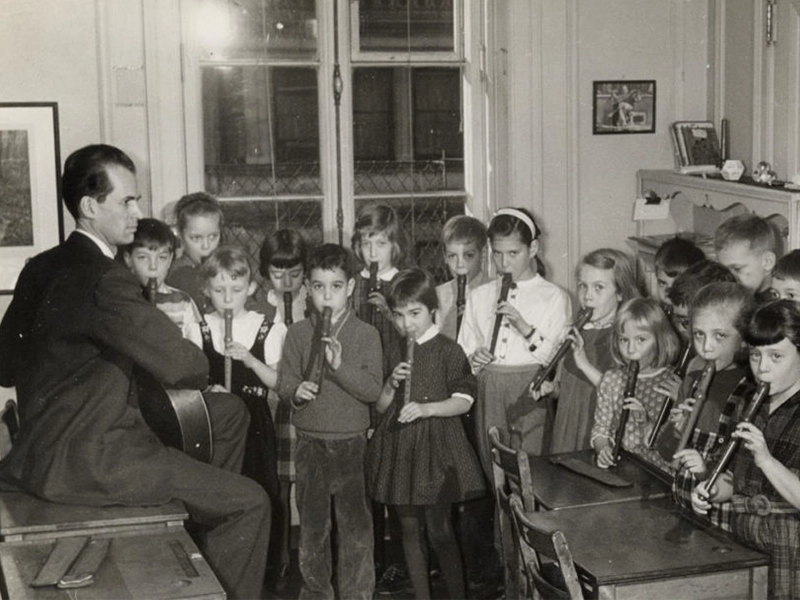
Waldorf Eğitiminin Temelleri
Waldorf eğitimi, çocukların üç farklı gelişimsel aşamadan geçtiği inancına dayanır: erken çocukluk, orta çocukluk ve ergenlik. Bu aşamaların her biri, çocuğun doğal büyümesini ve öğrenme kapasitesini destekleyen bir şekilde Waldorf müfredatı aracılığıyla ele alınan belirli gelişimsel ihtiyaçlarla karakterize edilir.
Erken Çocukluk
Erken çocukluk döneminde Waldorf eğitimi oyun, taklit ve duyusal deneyimler yoluyla öğrenmeye odaklanır. Waldorf sınıf ortamı kasıtlı olarak basittir ve doğayla bir bağ oluşturan ahşap oyuncaklar ve yün gibi doğal malzemelerle doludur. Waldorf eğitiminin bu aşaması çocukların yemek pişirme, temizlik ve bahçecilik gibi anlamlı görevler aracılığıyla fiziksel bedenlerini ve duyularını geliştirmelerine olanak tanır.
Waldorf okul öncesi müfredatının kritik yönleri şunlardır:
- Yaratıcı Oyun: Oyun temelli öğrenme bu aşamada Waldorf pedagojisinin temel taşıdır. Çocukların yaratıcılığı teşvik eden basit, doğal oyuncaklarla hayal gücüne dayalı oyunlar oynamaları teşvik edilir.
- Hikaye Anlatımı ve Ritim:Sözlü hikaye anlatımı, şarkılar ve şiirler günlük aktivitelerin merkezinde yer alır ve çocuklara güven duygusu veren ritmik bir yapı sağlar.
- Pratik Yaşam Becerileri:Çocuklar, motor becerilerini geliştirmeye ve bağımsızlığı teşvik etmeye yardımcı olan ekmek pişirme, sınıfı toplama, bahçeye bitki dikme gibi görevlere katılırlar.
Waldorf Öğretim Yöntemi, bu aşamada çocukların fiziksel, duygusal ve hayal gücü kapasitelerini beslemeye vurgu yapar. Çocuklar, pratik görevler ve oyun yoluyla dünyayı deneyimler ve gelecekteki akademik öğrenmeyi destekleyen temel beceriler geliştirir. Bu seviyedeki Waldorf sınıfı, çocukların çevreleriyle daha doğrudan etkileşim kurması gerektiği yönündeki Waldorf felsefesiyle uyumlu olarak, bilerek yüksek teknolojili aletlerden veya ekranlardan arındırılmıştır.
Waldorf okul öncesi eğitim kurumlarında öğretmen, çocukların taklit edebileceği davranışları modellemede önemli bir rol oynar. Bu, Waldorf Öğretim Yöntemi'nin bir diğer temel ilkesini vurgular: Çocuklar, bu kadar erken bir aşamada doğrudan öğretimle değil, örnek alarak daha iyi öğrenirler. Waldorf sınıfları genellikle dingin ve besleyici alanlar olarak tanımlanır, yaratıcı oyun ve keşifleri teşvik eder.
Orta Çocukluk
Waldorf okullarında, entelektüel öğrenme orta çocuklukta şekillenmeye başlar. Ancak, Steiner'ın felsefesine uygun olarak, Waldorf eğitim yöntemi hala entelektüel gelişim için birincil araçlar olarak deneyimsel öğrenme ve sanatsal ifadeyi vurgular.
Bu aşamaya yönelik Waldorf müfredatının temel unsurları şunlardır:
- Ana Ders Blokları: Matematik, edebiyat ve fen gibi akademik dersler, öğrencilerin kendilerini konuya tamamen kaptırabilmeleri için birkaç hafta süren yoğun bloklar halinde öğretilir.
- Sanatsal Entegrasyon:Waldorf sınıfındaki her ders sanatsal yöntemlerle öğretilir; çizim, boyama, hikaye anlatımı ve drama, karmaşık fikirleri daha somut ve ilişkilendirilebilir kılmak için kullanılır.
- Pratik Aktiviteler: Waldorf felsefesine uygun olarak çocuklar aynı zamanda bilişsel ve fiziksel becerileri bütünleştiren el sanatları ve ağaç işçiliği gibi pratik işlerle de meşgul olurlar.
Bu dönemde Waldorf okulu felsefesi duygusal zekânın gelişimini teşvik eder, yaratıcılığı, hayal gücünü ve iş birliğini vurgular.
Orta çocukluk dönemindeki Waldorf Öğretim Yöntemi, çocukların duygusal ve entelektüel olarak gelişmelerine yardımcı olarak onları ergenliğin daha zorlu akademik taleplerine hazırlar. Waldorf okullarındaki öğretmenlerin birkaç yıl boyunca aynı öğrenci grubuyla birlikte kaldıkları ve istikrarlı bir öğrenme ortamına katkıda bulunan güçlü, güvenilir ilişkiler geliştirdikleri bilinmektedir. Bu süreklilik, Waldorf eğitim sisteminin, öğrencilerin sık sık öğretmen değiştirdiği geleneksel okullardan ayıran önemli bir özelliğidir.
Waldorf eğitimi ayrıca orta çocukluk döneminde açık hava oyunlarına ve doğayla bağlantıya vurgu yapar. Çocukların çevreyle bağlantı kurmasına yardımcı olmak için günlük açık hava etkinlikleri, doğa yürüyüşleri ve saha gezileri Waldorf müfredatına entegre edilir ve bu da Waldorf okullarının temel değerlerini daha da yansıtır.
Ergenlik
Çocuklar ergenliğe girerken, Waldorf müfredatı eleştirel düşünmeyi, etik düşünceyi ve sosyal sorumluluğu teşvik etmeye geçiş yapar. Bu aşamada Waldorf okulları bağımsız öğrenmeyi, toplum katılımını ve kişisel ilgi alanlarını takip etmeyi vurgular.
Bu aşamanın temel unsurları şunlardır:
- Eleştirel Düşünme: Ergenlerin akıl yürütme ve düşünme yeteneklerini geliştirmek için felsefi tartışmalara, araştırma projelerine ve analitik görevlere katılmaları teşvik edilir.
- Hizmet Öğrenimi:Waldorf ilkeleri doğrultusunda, öğrenciler sosyal sorumluluk ve etik bilinci vurgulayan toplumsal hizmet projelerine katılırlar.
Bu aşamada, Waldorf Öğretim Yöntemi, ergenlerin toplum ve daha geniş dünya içindeki rollerini anlamalarına yardımcı olur. Waldorf öğretmenleri, öğrencilerin bağımsızlık ve güçlü bir amaç duygusu geliştirmelerine destek olan mentorlar haline gelir.
İçinde Waldorf okulları, ergenlik, kendini keşfetme ve kişisel gelişim zamanıdır. Müfredat, öğrencileri entelektüel ve duygusal olarak zorlamak, onları topluma olumlu katkıda bulunmaya hazır, empatik, düşünceli bireyler olmaya yönlendirmek için tasarlanmıştır. Dünya çapındaki Waldorf eğitim okulları, öğrencilerin yalnızca akademik başarının ötesinde çok yönlü bir eğitimle mezun olmalarını sağlamak için bu ilkeleri uygulamaya devam etmektedir.
Mükemmel sınıfınız bir tık uzağınızda!
Waldorf Eğitim İlkeleri
Birkaç temel ilke Waldorf eğitim felsefesini tanımlar. Bu ilkeler öğretmenlerin öğrencilerle nasıl etkileşime gireceğini ve bütünsel bir öğrenme deneyimi geliştirmek için müfredatı nasıl şekillendireceğini yönlendirir.
İnsan Ruhsal Bir Varlık Olarak
Waldorf pedagojisindeki temel inançlardan biri, çocukların benzersiz kaderlere sahip ruhsal varlıklar olduğudur. Waldorf öğretim yöntemi, çocuğun ruhsal gelişimini dini anlamda değil, hayata karşı bir hayranlık ve saygı duygusu besleyerek teşvik eder. Waldorf sınıfları, doğal malzemelerin güzelliği, mevsimsel ritimler ve sanatsal ifade yoluyla hayranlık uyandırmak için tasarlanmıştır.
Waldorf Öğretim Yöntemi, günlük, haftalık ve mevsimsel ritimlerin küçük çocuklar için öngörülebilir, güvenli bir ortam yaratmaya yardımcı olduğu doğal dünyanın ritimleriyle yakından uyumludur. Örneğin bir Waldorf okul öncesinde şarkılar, şiirler ve mevsimsel aktiviteler çocukların zamanın doğal akışıyla bağlantı kurmasına yardımcı olur. Waldorf eğitiminin manevi yönü, her çocuğun benzersiz potansiyelinin ve benlik duygusunun gelişimini vurgular ve onların empatik, sosyal açıdan sorumlu bireyler olarak büyümelerine yardımcı olur.
Öğretimde Özgürlük
Waldorf sisteminde öğretmenlere ders verme konusunda önemli bir özgürlük tanınır. Waldorf eğitim yöntemi, eğitimcilerin müfredatı öğrencilerinin ihtiyaçlarına ve ilgi alanlarına göre uyarlamalarına olanak tanır ve öğrenmenin ilgi çekici ve alakalı kalmasını sağlar. Bu yaratıcı özgürlük, katı müfredatların bireyselleştirilmiş öğrenme deneyimlerini sınırlayabildiği Waldorf okullarını geleneksel eğitim sistemlerinden ayırır.
Waldorf öğretmenlerine merak ve yaratıcılığı teşvik eden dersler hazırlama özerkliği verilir. Çocukların gelişimine ilişkin gözlemlerini, öğretimin içeriğine ve yöntemlerine rehberlik etmek için kullanırlar. Bu özgürlük, Waldorf okullarındaki öğretmenlerin her çocuk için öğrenme deneyimini kişiselleştirmelerine olanak tanır ve eğitimi standart bir süreç olmaktan çıkarıp organik ve gelişen bir süreç haline getirir.
Waldorf Öğretim Yöntemi, öğretmenin hem bir eğitimci hem de yaratıcı bir rehber olarak rolünü önemseyerek, öğrencilerin ilgi ve yeteneklerini keşfetmelerini teşvik eden dinamik, duyarlı öğrenme ortamları yaratır.
Deneyimsel Öğrenme ve İlişki Kurma
Waldorf eğitimi, çocukların uygulamalı aktiviteler aracılığıyla konularla etkileşime girdiği deneyimsel öğrenmeye öncelik verir. İster resim, ister bahçe işleri veya hikaye anlatımı olsun, bir Waldorf sınıfındaki öğrenciler yaparak öğrenirler. Ayrıca, öğretmen ve öğrenci arasındaki yakın ilişki, Waldorf pedagojisinin bir diğer ayırt edici özelliğidir. Öğretmenler genellikle aynı öğrenci grubuyla birkaç yıl kalır ve öğrenme deneyimini geliştiren derin bağlantılar kurarlar.
Waldorf Öğretim Yöntemi, sınıf içinde oluşan ilişkilere büyük önem verir. Öğrencilere birkaç yıl boyunca aynı öğretmenin rehberlik etmesi, güçlü bir güven ve anlayış bağı oluşturur ve öğrencilerin kendilerini ifade edebilecekleri ve öğrenmelerinde risk alabilecekleri destekleyici bir ortam yaratır. Bu süreklilik, Waldorf eğitim sistemi için olmazsa olmazdır ve bir çocuğun okul yolculuğu boyunca istikrar ve duygusal güvenliği teşvik eder.
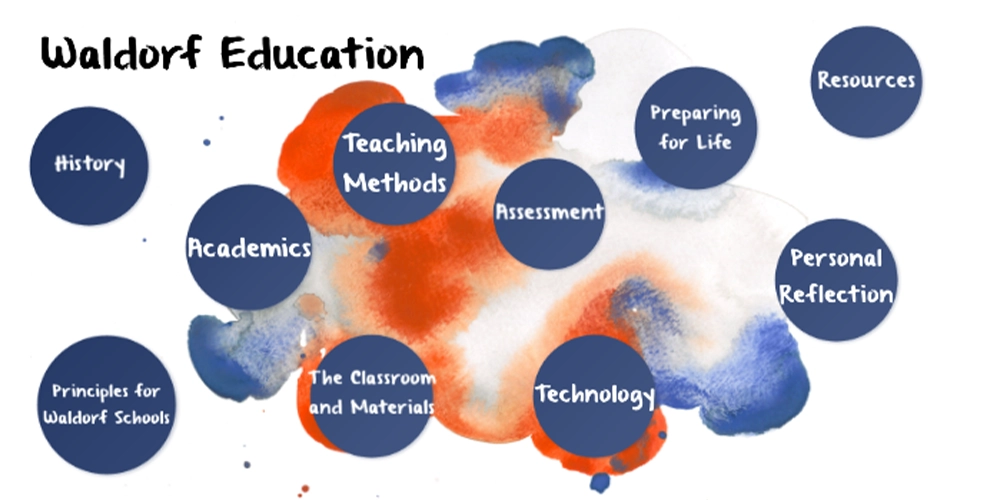
Waldorf Öğretim Yönteminin Artıları ve Eksileri
Okul öncesi ortamlar için Waldorf eğitim sistemini değerlendirirken, güçlü yönlerini ve olası zorluklarını değerlendirmek esastır. Aşağıda Waldorf yaklaşımının artıları ve eksilerine dair kapsamlı bir bakış bulunmaktadır.
Artıları:
- Öğrenme uygulamalı ve yaşa uygundur
Waldorf öğretim yöntemi, deneyimsel, dokunsal öğrenmeye vurgu yaparak çocukların gelişim düzeylerine uygun etkinliklere katılmalarına olanak tanır. - Öğrenme oyun temellidir
Oyun, Waldorf okul öncesi eğitim kurumlarında öğrenmenin önemli bir parçasıdır; yaratıcılığı, bilişsel gelişimi ve sosyal becerileri destekler. - Sınıfta teknoloji kullanılmıyor.
Waldorf eğitim modeli, çocukların çevrelerindeki dünyayla doğrudan etkileşime girmelerini teşvik ederek, teknoloji kullanımını kasıtlı olarak en aza indirir. - Öğrenciler eğitimlerinde aktif rol almayı öğrenirler
Waldorf yöntemi, çocukların kendi kendine öğrenen bireyler olmasını teşvik ederek, bağımsızlık ve merak duygularını destekler. - Waldorf okulları çok yönlü bireyler yetiştirir.
Waldorf eğitiminin bütünsel yaklaşımı, çocukların entelektüel, duygusal ve sanatsal kapasitelerinin gelişimini destekleyerek çok yönlü bireyler olmalarına yardımcı olur. - Waldorf eğitimli bireyler, öğrenmeye karşı yaşam boyu süren bir tutkuya sahiptir
Waldorf okullarının mezunları, Waldorf felsefesinin merak ve hayranlık duygusu aşılaması nedeniyle, hayatları boyunca derin bir öğrenme sevgisini korurlar.
Eksileri:
- Akademik çalışmalara odaklanma eksikliği
- Waldorf eğitimini eleştirenler, okuma ve matematik gibi resmi akademik derslerin geç başlatılmasının, öğrencileri geleneksel ortamlardaki akranlarına kıyasla dezavantajlı konuma düşürebileceğini savunuyorlar.
- Öğretmenler aynı çocuklara yıllarca ders veriyor
- Bu durum güçlü ilişkileri teşvik etse de öğrencinin farklı öğretim stilleri ve bakış açılarına maruz kalmasını sınırlayabilir.
- Teknolojinin sınırlı kullanımı
- Birçok ebeveyn Waldorf eğitiminin teknolojiden uzak yaklaşımını takdir etse de, bazıları bunun öğrencileri teknoloji odaklı bir dünyaya hazırlıksız bırakabileceğini düşünüyor.
Waldorf eğitim okulları, teknolojiyi sınıflara dahil etme konusundaki isteksizlikleri nedeniyle sıklıkla eleştirilir. Bu yaklaşımın daha derin kişisel ve yaratıcı katılımı teşvik etmesi amaçlansa da, bazı ebeveynler ve eğitimciler, Waldorf okullarındaki çocukların modern dünya için gerekli dijital okuryazarlık becerilerini geliştiremeyebileceğinden endişe duymaktadır. Buna rağmen, Waldorf Öğretim Yöntemi'nin birçok savunucusu, Waldorf okullarında yaratıcılık ve problem çözme becerilerine odaklanmanın öğrencileri gelecekteki zorluklara yeterince hazırladığını savunmaktadır.

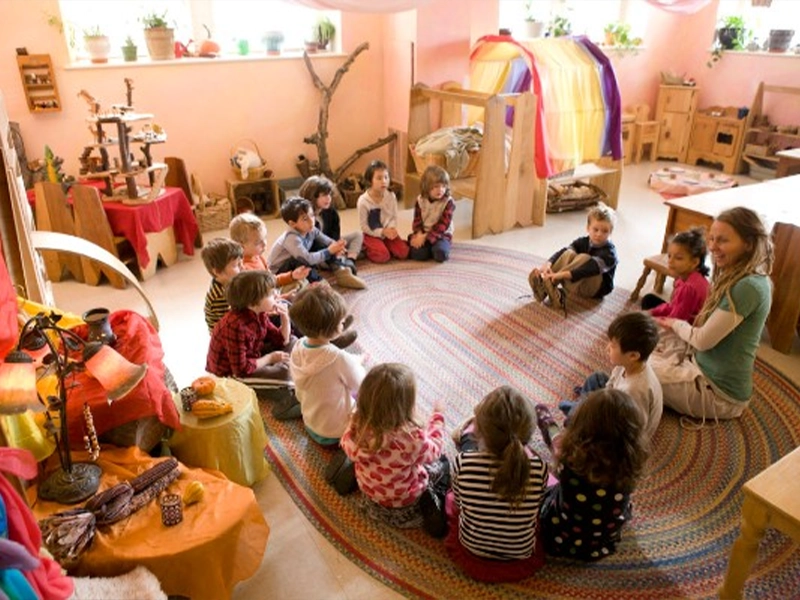
Waldorf Esintili Bir Öğrenme Ortamı Yaratmak
Waldorf'tan ilham alan bir sınıf, Waldorf Öğretim Yöntemi'nin özünü yansıtacak şekilde özenle tasarlanmıştır. Duvarların renginden mobilya seçimine kadar her ayrıntı, çocukların öğrenmesini ve refahını desteklemede rol oynar. Waldorf eğitiminin gerçekten gelişebileceği bir alan yaratmanın en kritik yönlerine bir göz atalım.
Waldorf Eğitiminde Sınıf Ortamının Önemi
Waldorf Öğretim Yönteminde, sınıf ortamı öğrenme sürecinin bir uzantısı olarak görülür. Waldorf okulları, çocukların yalnızca öğretilenlerden fazlasını özümsediklerini, her gün çevrelerinden derinden etkilendiklerini anlar.
- Sınıfın “Üçüncü Öğretmen” Olarak Kullanımı:
Waldorf eğitiminde, fiziksel sınıf sadece bir fon değil, aynı zamanda eğitim ekibinin aktif bir parçasıdır. Mekân, çocukların davranışlarını ve zihniyetlerini nazikçe yönlendirir. Bir Waldorf sınıfı bilinçli bir şekilde düzenlendiğinde, öğrenciler arasında odaklanmayı, yaratıcılığı ve iş birliğini doğal olarak destekler. Bu nedenle birçok Waldorf okulu, özenle planlanmış düzenlere, yumuşak aydınlatmaya ve düzenli alanlara yatırım yapar. - Sakin, Davetkar Mekanlar:
Waldorf sınıflarında canlı renkler veya sert ışıklar kullanılmaz. Bunun yerine yumuşak tonlar, doğal güneş ışığı ve bolca sessiz köşeler bulunur. Bu ortam, çocukların kendilerini güvende ve rahat hissetmelerine yardımcı olur ve bu da onları keşfetmeye, soru sormaya ve yeni şeyler denemeye teşvik eder. Sakin bir ortam, Waldorf eğitiminin bir özelliğidir ve Waldorf öğretim yaklaşımının başarısıyla yakından bağlantılıdır. - Hareket ve Esneklik:
Geleneksel sınıfların aksine, Waldorf sınıfı sabit değildir. Grup çalışması, grup zamanı veya yaratıcı oyunlar için alan yaratmak amacıyla mobilyalar hareket ettirilebilir. Esnek düzenler hem bağımsızlığı hem de iş birliğini teşvik eder. Çocuklar, Waldorf eğitim okullarında temel bir değer olan sorumluluk ve ortak alanlara saygıyı öğreten sınıf düzenlemelerine katılmaya davet edilir. - Duyularla Bağlantı:
Yün halının dokusundan ahşap rafların kokusuna kadar her unsur, çocukların duyusal gelişimini destekleyecek şekilde seçilmiştir. Waldorf öğrenme yöntemi, öğretmenleri dokunma ve etkileşimi teşvik eden materyaller kullanmaya teşvik eder. Bu duyusal deneyimler, çocukları içinde bulundukları ana odaklar ve çevreleriyle bağlantı kurmalarına yardımcı olur. - Waldorf Müfredatını Desteklemek:
Özenle tasarlanmış bir sınıf, Waldorf müfredatının tüm bölümlerini destekler. İster rahat bir köşede hikaye anlatmak, ister güneşli bir masada resim yapmak, ister sabah şarkıları eşliğinde bir araya gelmek olsun, ortam her öğrenme deneyimini zenginleştirir. Waldorf Öğretim Metodu, çocukların sınıfları da derslerin kendisi kadar besleyici ve ilham verici olduğunda başarılı olduklarını hatırlatır.
Waldorf Sınıfları İçin Doğru Malzeme ve Mobilya Seçimi
Seçim doğru mobilya ve materyaller, otantik bir Waldorf sınıfı yaratmanın önemli bir parçasıdır. Yaptığınız seçimler, yalnızca okulun görünümünü ve hissini değil, aynı zamanda çocukların her gün nasıl öğrendiklerini ve etkileşim kurduklarını da şekillendirecektir.
- Waldorf Tasarımının Kalbinde Doğal Malzemeler:
Waldorf okulları ve anaokulları, mobilya ve sınıf malzemeleri için ahşap, yün ve pamuk gibi doğal malzemeleri tercih eder. Masif ahşap sandalyeler, çocuk masaları ve doğal ahşap raflar yaygın seçeneklerdir. Bu parçalar hem dayanıklı ve güvenlidir hem de çocukların Waldorf eğitim felsefesinin temel bir fikri olan doğayla bağ kurmasına yardımcı olur. Ayrıca yün halılar, pamuklu perdeler ve el dokuması sepetler de sıklıkla bulunur. - Çocuk Boyu ve Ergonomik Mobilyalar:
Waldorf Öğretim Yöntemi bağımsızlığa değer verir, bu nedenle mobilyalar çocuk düşünülerek seçilir. Alçak masalar, küçük ahşap sandalyeler, açık kitaplıklar ve vestiyerlerin çocuğun boyuna göre yerleştirilmesine dikkat edin. Ergonomik tasarım, Waldorf pedagojisinde önemli olan iyi duruşu ve sağlıklı hareketi destekler. - Basitlik ve Çok Yönlülük:
Waldorf sınıflarında, açık uçlu oyunu teşvik etmek için mobilyalar ve malzemeler sade tutulur. Oyun standları (ipekleri örtmek veya yaratıcı sahneler yaratmak için kullanılan ahşap çerçeveler) bir kukla tiyatrosuna, mağazaya veya okuma köşesine dönüştürülebilir. Sanat sehpaları, bloklar için büyük dokuma sepetler ve istiflenebilir tabureler, çok yönlü kullanım sunar ve Waldorf öğrenme yaklaşımını destekler. - Güvenlik ve Sürdürülebilirlik:
Güvenlik her zaman bir önceliktir. Waldorf eğitim okulları, pürüzsüz kenarlara, sağlam tabanlara ve toksik olmayan yüzeylere sahip mobilyalar seçer. Sürdürülebilir üretim de, Waldorf'un dünyaya saygı ilkeleriyle uyumlu olması açısından önemlidir. Çevre dostu ürünleri göz önünde bulundurun. ahşap mobilyalar, bambu depolama rafları veya sınıfınız için FSC sertifikalı ürünler. - Estetik Uyum:
Waldorf sınıfındaki her eşya, güzellik ve düzen duygusunu destekleyecek şekilde seçilmiştir. Uyumlu renkler, yumuşak kumaşlar ve doğal dokular huzurlu bir atmosfer yaratır. Mekanda sıklıkla yün halılar, pamuklu minderler ve doğadan ilham alan dekoratif öğeler göreceksiniz.
Waldorf Sınıfı için Ürün Kontrol Listesi
| Ürün Türü | Açıklama / Kullanım | Waldorf Özellikleri |
|---|---|---|
| Çocuk Boy Ahşap Masalar | Grup çalışmaları, yemekler ve sanat etkinlikleri için | Doğal malzemeler, ergonomik tasarım |
| Ahşap Sandalyeler | Doğru duruşu ve bağımsızlığı destekler | Sağlam, çocuk boyutunda, taşınması kolay |
| Açık Raflar/Kitaplıklar | Kitaplar, oyuncaklar ve sınıf materyalleri için depolama | Kolay erişim için düşük yükseklik, doğal ahşap |
| Oyun Standları / Kukla Tiyatroları | Hayal gücüne dayalı oyun ve sahne yaratma için | Çok yönlü, yaratıcılığı teşvik eder |
| Sanat Şövaleleri ve El Sanatları Masaları | Resim, çizim ve el sanatları | Ayarlanabilir, temizlemesi kolay |
| Büyük Dokuma Sepetler | Blokları, oyuncakları ve sanat malzemelerini düzenleyin | Yumuşak, doğal lifler, esnek kullanım |
| Yün veya Pamuklu Alan Halıları | Grup alanlarını ve okuma köşelerini tanımlayın | Yumuşak doku, doğal renkler |
| Yer Minderleri ve Fasulye Torbaları | Rahat, davetkar okuma veya dinlenme alanları yaratın | Rahat, güvenli malzemeler |
| Doğa Masaları/Sergileme Rafları | Mevsimlik ürünleri ve doğa koleksiyonlarını göster | Sınıfı doğaya bağlar |
| Çocuk Boyu Askılıklar | Bağımsızlığı ve düzeni teşvik edin | Kişisel bakım için uygun yükseklik |
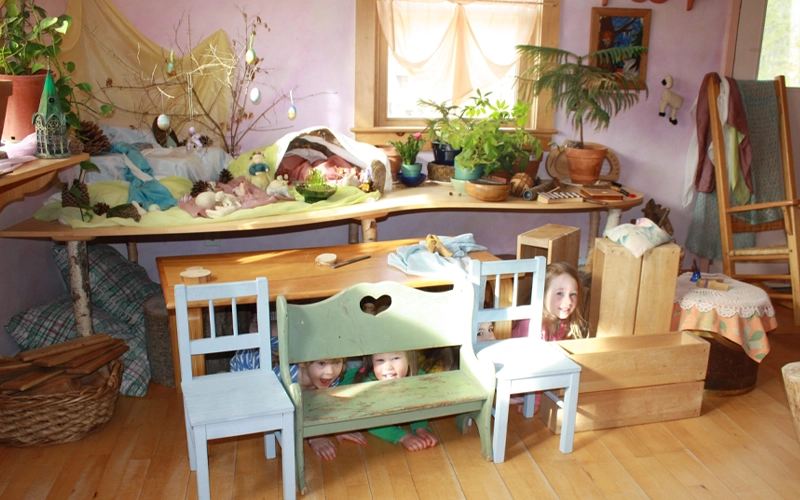
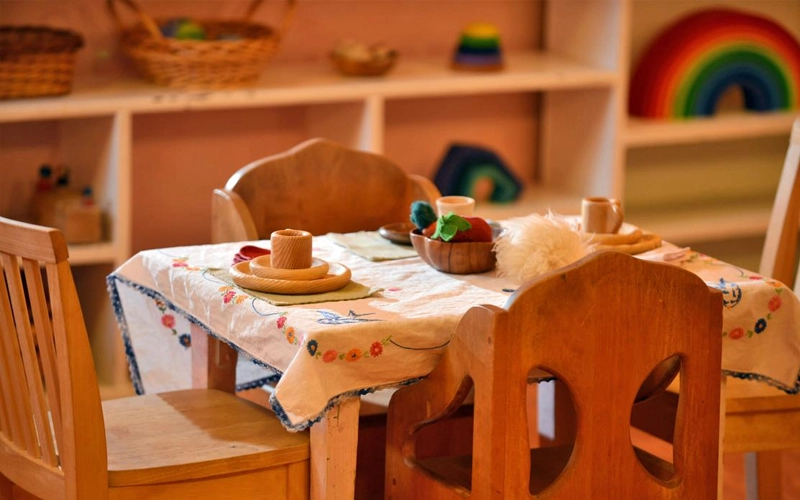
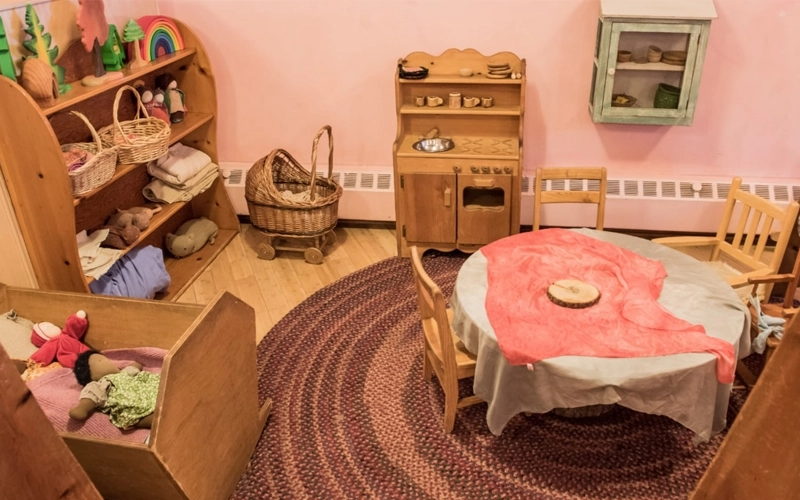
Açık Uçlu Oyun ve Öğrenme Alanları Tasarlamak
Waldorf Öğretim Yöntemi'nin temel özelliklerinden biri, açık uçlu oyunlara ve uygulamalı keşiflere yer açmaktır. Waldorf sınıflarında öğretmenler, hayal gücünü ve sosyal gelişimi teşvik etmek için düşünceli düzenler ve çok yönlü ürünler kullanır.
- Hayal Gücünü Kullanan Çocuklar İçin Esnek Alanlar:
Waldorf okulları, sadece birkaç ipek eşarp veya kumaş parçasıyla bir dükkan, tiyatro veya rahat bir sığınak haline gelebilen oyun standlarından büyük ölçüde yararlanır. Ahşap yapı blokları, istiflenebilir kasalar ve basit masalar, çocukların kendi oyun dünyalarını tasarlamalarına olanak tanır. - Basit, Çok Amaçlı Malzemeler:
Waldorf sınıflarındaki oyuncaklar ve aksesuarlar çok yönlülükleri göz önünde bulundurularak seçilir. Waldorf bebekleri, tahta hayvanlar, dokuma sepetler, keçe paspaslar ve ipek eşarplar, çocukların kendi hikayelerini yaratmalarına, manzaralar inşa etmelerine ve hareketi keşfetmelerine olanak tanır. Bu, Waldorf'un yaparak öğrenme felsefesini destekler. - Ekran veya Pil Oyuncakları Yok:
Waldorf pedagojisine göre, sınıfta elektronik aletler kullanılmaz. Bunun yerine çocuklar ahşap bulmacalar, doğadan ilham alan nesneler ve yaratıcı el işi malzemeleriyle derinlemesine ilgilenirler. - Farklı Aktiviteler İçin Bölgeler:
Alanlar çeşitli kullanımlar için düzenlenmiş: Yer minderleri ve alçak bir kitaplık bulunan bir okuma köşesi, ağaç dilimleri ve gevşek parçaların bulunduğu sepetlerin bulunduğu bir bina alanı, boyalar ve kil bulunan bir sanat masası ve hikaye anlatımı için bir kukla sahnesi. - Sosyal ve Duygusal Gelişimi Teşvik Etmek:
Bu açık uçlu kaynaklar sayesinde çocuklar doğal olarak işbirliği yapmayı, paylaşmayı ve iletişim kurmayı öğrenirler ki bu da Waldorf eğitiminin bir özelliğidir.
Tipik Waldorf Oyun ve Öğrenme Ürünleri:
| Ürün | Sınıfta Kullanım |
|---|---|
| Oyun Standları | Kaleler, dükkanlar, kukla tiyatroları inşa etmek |
| Ahşap Yapı Blokları | Yaratıcı yapı, sayma ve sıralama |
| İpek Eşarplar ve Kumaşlar | Hayal gücüne dayalı oyunlar için kostümler, hareketler, sahne dekorları |
| Waldorf Bebekleri ve Kuklaları | Hikaye anlatımı, rol yapma, sosyal öğrenme |
| Dokuma Sepetler | Oyuncakları, doğal nesneleri veya sanat malzemelerini saklamak |
| Yer Minderleri ve Halılar | Okuma, dinlenme veya çember zamanı için rahat alanlar |
| Sanat Şövaleleri ve El Sanatları Masaları | Resim, çizim, ortak projeler |
| Alçak Raflar ve Kitaplıklar | Erişilebilir depolama, çocuklar için kitap sergileme alanı |
| Ağaç Dilimleri ve Gevşek Parçalar | İnşa etme, istifleme, doğa temelli keşif |
Bu açık uçlu ürünler, Waldorf Öğretim Yöntemi'ni hayata geçirmeye yardımcı olur ve her sınıfı yaratıcılığın, bağımsızlığın ve keşfin günlük yaşamın bir parçası olduğu bir yere dönüştürür.
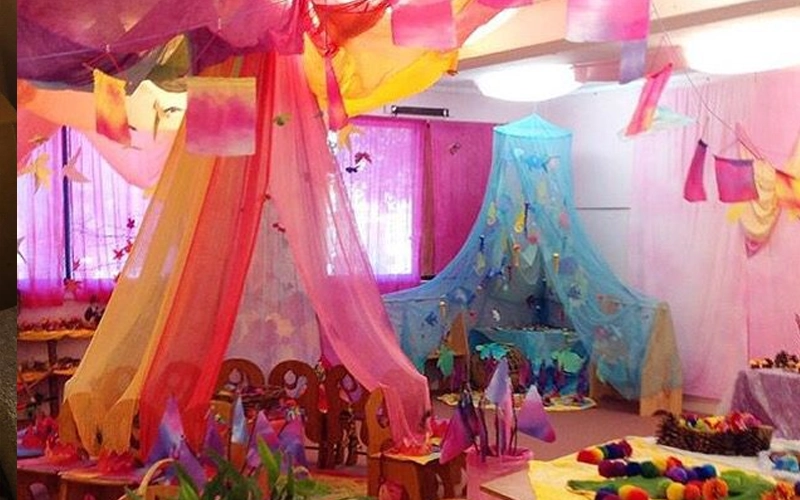


Doğayı ve Mevsimsel Ritmi Sınıfa Getirmek
Waldorf Öğretim Yöntemi, çocukları doğayla buluşturmaya ve mevsimlerin ritmine saygı duymaya büyük önem verir. Bir Waldorf sınıfında, ortam, Waldorf pedagojisi ve felsefesinin temel bir parçası olan doğal dünyanın döngülerini yansıtacak şekilde özenle tasarlanır.
- Doğa Masaları ve Mevsimsel Sergiler:
Waldorf okullarında ve Waldorf eğitim anaokullarında doğa masası merkezi bir unsurdur. Çocuklar, taş, yaprak ve çiçek gibi mevsimlik eşyaları toplayıp sergileyerek sınıfı doğanın değişimlerinin canlı bir yansımasına dönüştürürler. Bu uygulamalı etkinlik, Waldorf Öğretim Yöntemi'nin bir özelliğidir ve gözlemlemeyi ve dünyaya saygıyı teşvik ederek Waldorf öğrenme yaklaşımını destekler. - Doğal Işığın ve Bitki Yaşamının Maksimize Edilmesi:
Tipik bir Waldorf sınıfı, çocukların refahını ve öğrenmesini destekleyen güneş ışığı ve temiz hava ile doludur. Waldorf eğitim okullarında bitkiler ve iç mekan bahçeleri yaygındır ve öğrencilerin canlılara bakmayı öğrenmelerine yardımcı olur. Waldorf okullarındaki öğretmenler, ortama doğal renkler ve güzellik katmak için pencere kristalleri veya güneş tutucular kullanabilirler. - Mevsimlik El Sanatları ve Doğal Dekorasyonlar:
Waldorf müfredatı, yün, keçe ve ahşap kullanılarak yapılan birçok el işi içerir. Çocuklar, bahar çelenkleri veya sonbahar mobilleri gibi her mevsimi kutlayan süslemeler ve sanat projeleri yaratırlar. Bu yaratıcı etkinlik, Waldorf metodolojisinin merkezinde yer alır ve Waldorf sınıfının ritmini oluşturmaya yardımcı olur. - Açık Hava Öğrenimi ve Doğa Yürüyüşleri:
Waldorf yaklaşımı, ister okul bahçesinde ister doğa yürüyüşlerinde olsun, dışarıda düzenli zaman geçirmeyi teşvik eder. Bu deneyimler, Waldorf eğitim sistemine derinlemesine entegre edilmiştir ve çocukların doğrudan deneyim yoluyla öğrenmelerine yardımcı olur ve Waldorf Öğretim Yöntemi'nin değerlerini pekiştirir. - Günlük ve Haftalık Ritimler:
Waldorf eğitim felsefesini benimseyen öğretmenler, doğanın ritmiyle uyumlu rutinler ve mevsimsel festivaller planlar. Sabah çemberleri, haftalık pişirmeler ve mevsimsel kutlamalar, Waldorf sisteminin uygulamaya konmasının klasik örnekleridir.
Her Waldorf sınıfında, bu doğal unsurlar ve ritimler öğrenmeyi canlandırır. Waldorf Öğretim Yöntemi, çocuklara çevrelerindeki dünyayı fark etmeyi ve daha büyük bir şeyin parçası gibi hissetmeyi öğretir; bu da Waldorf eğitiminin benzersiz özelliklerinin önemli bir parçasıdır.
Mükemmel sınıfınız bir tık uzağınızda!
Düzen Yoluyla Bağımsızlığı ve Yaratıcılığı Desteklemek
Waldorf Öğretim Yöntemi'nin temel amaçlarından biri, çocukların bağımsız düşünen ve yaratıcı problem çözücüler olmalarına yardımcı olmaktır. Bir Waldorf sınıfının düzenlenme şekli, her çocuğun hem bağımsızlığını hem de yaratıcılığını desteklemede büyük bir fark yaratabilir.
- Erişilebilir Mobilya ve Malzemeler:
Waldorf okullarında tüm masalar, sandalyeler, raflar ve depolama üniteleri çocuk dostu bir yüksekliktedir. Bu, çocukların ihtiyaç duydukları şeyleri bulmalarını, aktivitelerden sonra ortalığı toplamalarını ve gün boyunca kendi seçimlerini yapmalarını teşvik eder. Waldorf sınıfı, Waldorf eğitim felsefesinin temel ilkelerinden biri olan çocukları güçlendirmek ve özgüvenlerini geliştirmek için tasarlanmıştır. - Serbest Hareket İçin Açık Düzenler:
Waldorf Öğretim Yöntemi, açık yollar içeren açık kat planları önerir. Mobilyalar, çocukların oyun alanları, okuma köşeleri ve sanat masaları gibi aktivite alanları arasında serbestçe hareket edebilecekleri şekilde düzenlenmiştir. Bu özgürlük, Waldorf pedagojisinde değer verilen yaratıcı keşif, iş birliği ve fiziksel koordinasyonu destekler. - Seçim ve Esneklik:
Waldorf yaklaşımı, çocukların nerede ve nasıl çalışacaklarını veya oynayacaklarını seçmelerine olanak tanır. Okumak için sessiz bir köşe, grup çalışması için geniş bir masa veya inşa etmek için açık bir alan gibi birden fazla alan, öğrencilerin ilgi alanlarını takip etmelerine ve bireyselliklerini ifade etmelerine olanak tanır. Bu, Waldorf öğrenme yönteminin benzersiz özelliklerini destekler. - Kendi Kendine Yönelik Etkinlikler:
Waldorf eğitim modelini kullanan öğretmenler, kendi kendine başlatılan projeleri ve açık uçlu görevleri teşvik eder. Materyaller, çocukların kendi başlarına aktivitelere başlayabilmeleri ve bitirdiklerinde toparlanabilmeleri için düzenli ve davetkar bir şekilde sergilenir. Bu rutin, öğrencilerin sınıfta sorumluluk ve sahiplik duygusu geliştirmelerine yardımcı olur. - İşbirliğini Teşvik Etmek:
Bağımsızlık önemli olmakla birlikte, düzen aynı zamanda ekip çalışmasını da teşvik eder. Grup oturma düzeni, ortak materyaller ve halka zamanı veya performanslar için açık alanlar, öğrencilere birlikte çalışma, fikir paylaşma ve sorunları kolektif olarak çözme fırsatı sunar; bu da Waldorf eğitim sisteminin temel bir unsurudur.
Waldorf Öğretim Metodu, düşünceli bir sınıf düzeniyle çocukların yaşam becerilerini, öz motivasyonlarını ve yaratıcı özgüvenlerini geliştirebilecekleri bir ortam yaratır; bu nitelikler okul öncesi yıllarının çok ötesine uzanır.
Açık Hava Öğrenme Alanlarının Entegre Edilmesi
Waldorf Öğretim Yöntemi'nde öğrenme sınıf kapısında bitmez. Açık hava alanları, Waldorf okul ortamının hayati bir uzantısı olarak görülür ve çocuklara temiz hava, hareket ve doğayla bağlantı kurmak için sonsuz fırsatlar sunar.
- Doğayı Düşünerek Açık Hava Sınıfları Tasarlayın
Waldorf eğitim okulları genellikle bahçe alanları, kum havuzları veya açık havada sessiz köşeler oluşturur. Dış mekanı Waldorf felsefesiyle uyumlu tutmak için ahşap banklar, oturma yeri olarak ağaç kütükleri veya bambu çitler gibi doğal malzemeler kullanın. - Mevsimsel Faaliyetler için Plan
Doğa yürüyüşleri, bahçe işleri ve mevsimsel kutlamalar için zaman ayırın. Çocuklar ilkbaharda soğan ekebilir, sonbaharda yaprak toplayabilir veya kışın kardan kaleler inşa edebilirler. Açık hava öğrenimi, Waldorf pedagojisinde çok önemli olan ritmi ve duyusal deneyimleri destekler. - Dışarıda Açık Uçlu Oyun Materyalleri Sağlayın
Kütük, taş, dal ve ip gibi gevşek parçaları inşa etmek ve keşfetmek için kullanın. Plastik oyun alanı ekipmanlarından kaçının; doğal unsurlar Waldorf yaklaşımına daha uygundur ve yaratıcılığı teşvik eder. - Korunaklı Alanlar Yaratın
Çocukların her türlü hava koşulunda dışarıda öğrenip oynayabilmeleri için gölgelik bir alan veya basit bir dış mekan barınağı ekleyin. Dış mekan tahtaları, alçak masalar ve doğa sanat istasyonları, dış mekan derslerine çeşitlilik katar. - Keşif ve Bağımsızlığı Destekleyin
Waldorf eğitiminde açık hava öğrenimi, çocuklara keşfetme özgürlüğü vermekle ilgilidir. Güvenli sınırlar, görünür öğretmenler ve basit temel kurallar, çocukların risk almalarına ve kendi hızlarında öğrenmelerine olanak tanır. - Waldorf Müfredatını Açık Havada Genişletin
Birçok Waldorf okulu, iç mekan rutinlerini dışarıya taşıyor; sabah çemberi, hikaye anlatımı, resim yapma ve hatta atıştırmalık zamanı bile dışarıda gerçekleşebiliyor. Bu uzantı, Waldorf Öğretim Yöntemi'nin benzersiz özelliklerini pekiştiriyor.
Açık hava öğrenme alanlarını düşünceli bir şekilde entegre etmek, çocukların gelişmesine yardımcı olacak, tüm çocuğun gelişimini destekleyecek ve Waldorf Öğretim Yöntemini okulunuzda veya okul öncesinde gerçekten hayata geçirecektir.
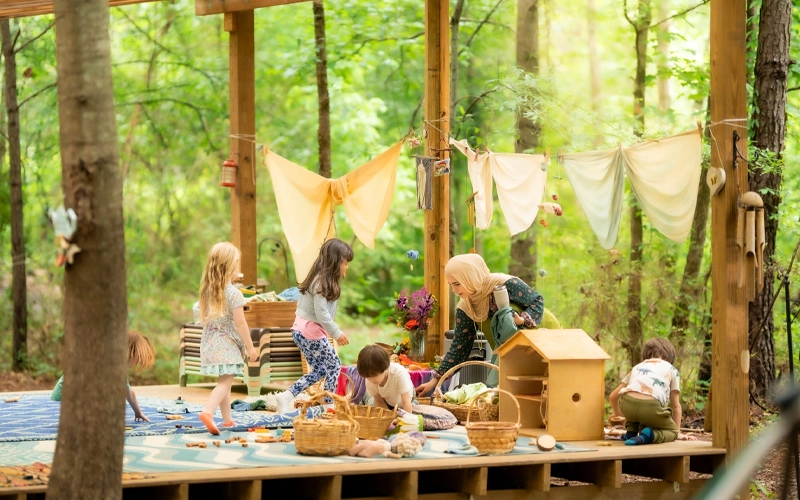
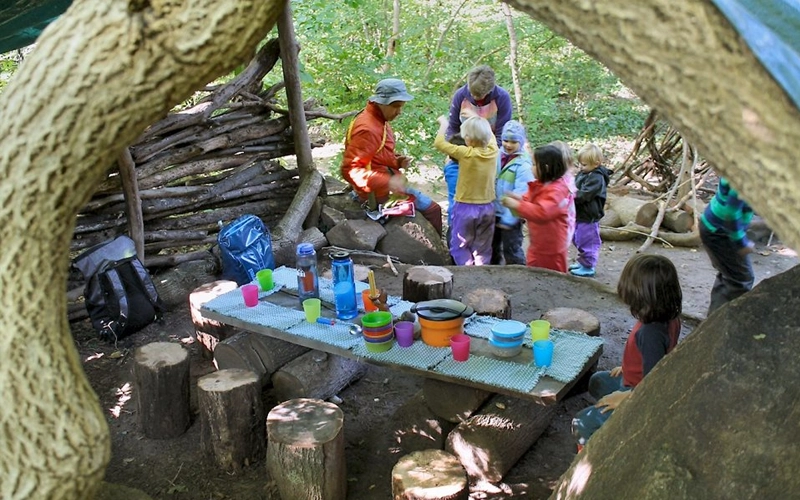
Waldorf Esintili Bir Sınıf Kurmak İçin Pratik İpuçları
Bir Waldorf sınıfı kurmak, sadece güzel mobilyalar seçmekten daha fazlasını gerektirir. Waldorf Öğretim Yöntemi, her çocuğun zihinsel, bedensel ve ruhsal gelişimini destekleyen bir ortam yaratmakla ilgilidir. İşte bir Waldorf eğitim sınıfı veya okul öncesi eğitim kurumu hazırlayan herkes için bazı pratik öneriler:
- Net Bir Planla Başlayın:
Herhangi bir mobilyayı içeri getirmeden önce, Waldorf sınıfının gün boyunca nasıl kullanılacağına karar verin. Günlük ve mevsimsel ritimleri, grup aktivitelerini, sessiz köşeleri ve hareket alanını göz önünde bulundurun. Waldorf pedagojisi esnekliğe ve akışa değer verir. - Doğal Malzemelere Öncelik Verin:
Masif ahşap masa ve sandalyeler, pamuklu veya yün halılar ve doğal elyaf perdeler seçin. Bu malzemeler, Waldorf okul ortamının sakin, davetkar ve sağlıklı olmasına yardımcı olur. Waldorf eğitim felsefesine sadık kalmak için mümkün olduğunca plastik veya metalden kaçının. - Tanımlı Bölgeler Oluşturun:
Sınıfı oyun, sanat, okuma ve grup çalışması alanlarına ayırmak için raflar ve mobilyalar kullanın. Waldorf Öğretim Yöntemi'nde, açık alanların olması, Waldorf öğrenme yönteminin benzersiz özelliklerini destekler. - Dekoru Basit ve Ritmik Tutun:
Dağınıklıktan ve gösterişli dekorasyonlardan kaçının. Bunun yerine mevsimlik el sanatları, doğa masaları ve yumuşak renkler sergileyin. Waldorf yaklaşımı, görsel ritmin çocukların kendilerini güvende ve ilham verici hissetmelerine yardımcı olduğuna inanır. - Çocuk Boyutlarında Mobilyalar ve Açık Depolama Alanları Kullanın:
Alçak masalar, sandalyeler ve raflar çocuklara bağımsızlık kazandırır. Waldorf eğitim okullarının ve Waldorf öğretim felsefesinin merkezinde yer alan bu özellik, materyallere kendi başlarına ulaşmalarını sağlar. - Hareket Planı:
Çember zamanı, oyunlar ve yaratıcı aktiviteler için yeterli açık alan sağlayın. Waldorf eğitim yöntemi, günlük rutinlerin bir parçası olarak hareketi teşvik eder. - Bakımı Kolaylaştırın:
Sınıfı düzenli ve temiz tutmak için yıkanabilir kılıflar, sağlam mobilyalar ve saklama sepetleri seçin. Waldorf Öğretim Yöntemi güzelliğe değer verir, ancak yoğun öğretmenler ve aktif çocuklar için pratik olmalıdır. - Waldorf Mobilya Tedarikçilerine Danışın:
Şüpheye düştüğünüzde, Waldorf sistemini anlayan ve vizyonunuza ve Waldorf müfredatına uygun ürünleri önerebilecek tedarikçilere ulaşın.
Waldorf'tan ilham alan bir sınıf ortamı oluşturmak, her çocuğun geleceğine bir yatırımdır. Seçimlerinizi yönlendirmek için Waldorf Öğretim Yöntemi'ni kullandığınızda, tıpkı Rudolf Steiner ve Waldorf okullarının amaçladığı gibi, çocukların gelişebileceği bir alan yaratırsınız.
Adım Adım Kılavuz: Waldorf Sınıfı Kurulumu
Bir Waldorf sınıfı kurmak ilk başta göz korkutucu görünebilir, ancak adım adım ilerleyen basit bir süreç bunu hem basit hem de etkili hale getirir. Waldorf Öğretim Yöntemi, özenli planlama, doğal malzemeler ve esnekliği vurgular. İşte sıfırdan sıcak ve ilham verici bir Waldorf sınıfı oluşturmanıza yardımcı olacak pratik bir rehber:
1. Adım: Sınıfın Amacını ve Günlük Ritmini Tanımlayın
- Alanın Waldorf okul öncesi, anaokulu veya ilkokul sınıfı için mi olacağına karar verin.
- Serbest oyun, halka zamanı, sanat, hikaye anlatımı ve açık hava etkinlikleri için zaman da dahil olmak üzere günlük ve haftalık ritminizi planlayın.
- Waldorf eğitim felsefesi, çocukların kendilerini güvende hissetmelerine yardımcı olan rutinlere ve geçişlere değer verir.
2. Adım: Sakin ve Işık Dolu Bir Alan Seçin
- Mümkün olduğunca doğal güneş ışığı alan ve iyi hava akışı olan bir oda seçin.
- Yumuşak duvar renkleri ve sade pencere kaplamaları, davetkar Waldorf sınıfı atmosferini destekliyor.
- Mobilyalarınızı doğal ışıktan faydalanacak şekilde düzenleyin ve bitki veya pencere kristalleri eklemeyi düşünün.
Adım 3: Doğal, Çocuk Boyutlarında Mobilya Seçin
- Masif ahşap masalara, çocuk ölçülerinde sandalyelere, açık raflara ve saklama sepetlerine yatırım yapın.
- Yolları açık tutun ve her çocuğun Waldorf pedagojisini izleyerek ve bağımsızlığı destekleyerek malzemelere bağımsız bir şekilde ulaşabildiğinden emin olun.
- Çocukların doğal olarak bir araya gelebileceği okuma köşeleri, sanat masaları ve doğa masaları yerleştirin.
4. Adım: Etkinlik Bölgelerini Düzenleyin
- İnşa etme, okuma, sanat, müzik ve yaratıcı oyun için alanları tanımlamak amacıyla raflar veya halılar kullanın.
- Çocukların ilgi alanları ve sınıf ihtiyaçları değiştikçe her alanı esnek hale getirin.
- Waldorf öğrenme yöntemi çeşitliliği teşvik eder; aşırı kalabalık oluşturmaz, ancak hareket ve keşif için alan bırakır.
Adım 5: Açık Uçlu Oyun Malzemeleri ve Mevsimsel Süslemeler Ekleyin
- Oyun standları, tahta bloklar, ipek eşarplar, Waldorf bebekleri ve el işi malzemeleri ekleyin.
- Doğadaki değişiklikleri yansıtmak için malzemeleri döndürün ve doğa tablolarını veya mevsimsel sergileri yıl boyunca güncelleyin.
- Waldorf yaklaşımı güzelliğe ve ritme değer verir, bu nedenle çocukların sanat eserlerini ve el yapımı süslemeleri sergileyin.
6. Adım: Düzenli ve Organize Bir Alan Sağlayın
- Çocuklara, eşyaları kullandıktan sonra kaldırarak sınıf ortamına özen göstermeyi öğretin.
- Kolay erişim ve temizlik için sepetler, tepsiler ve etiketli raflar kullanın.
- Düzenli bir ortam, Waldorf sınıfının ve Waldorf Öğretim Yönteminin kendine özgü özelliklerini destekler.
7. Adım: Misafirperver Bir Giriş Oluşturun ve Ailelerle İletişim Kurun
- Ebeveynlerin iletişim kurabileceği bir alan, vestiyer, ayakkabı rafı gibi eşyalarla samimi bir giriş hazırlayın.
- Ailelerin görebileceği günlük bir program, yaklaşan etkinlikler ve mevsimsel haberler gösterin.
- Waldorf eğitim sistemi güçlü ev-okul ortaklıklarını teşvik eder.
Hızlı İpuçları:
- Basitten başlayın ve ilerledikçe geliştirin; her Waldorf sınıfı gelişir.
- Öğretmenleri, çocukları ve velileri mekanın dekorasyonuna ve bakımına dahil edin.
- İhtiyaçlarınıza uygun özelleştirilmiş çözümler için Waldorf mobilya tedarikçilerine ulaşın.
Dikkatli bir planlama ve açık fikirlilikle herkes Waldorf Öğretim Yöntemini kullanarak çocukların ilham aldığı, değerli hissettiği ve her gün öğrenmeye hazır olduğu bir sınıf yaratabilir.
Sadece hayal etmeyin, tasarlayın! Özel mobilya ihtiyaçlarınız hakkında konuşalım!
Waldorf Sınıf Düzeninde Kaçınılması Gereken Yaygın Hatalar
Bir Waldorf sınıfı kurmak hem heyecan verici hem de zorlu olabilir. Waldorf Öğretim Yöntemi benzersizdir ve deneyimli öğretmenler veya okul yöneticileri bile Waldorf eğitimine yeni başlamış olsalar bile hata yapabilirler. İşte kaçınmanız gereken en yaygın hatalardan bazıları:
- Çok Fazla Ticari veya Plastik Malzeme Kullanımı
Waldorf okullarındaki en büyük hatalardan biri, sınıfları parlak renkli plastik oyuncaklar ve ticari ürünlerle doldurmaktır. Waldorf felsefesi, hayal gücünü harekete geçiren doğal ve sade malzemelere değer verir. Sınıf mobilyaları ve öğrenme materyalleri için her zaman ahşap, pamuk, yün ve diğer doğal lifleri tercih edin. - Alanı Aşırı Kalabalıklaştırmak
Çok fazla mobilya veya oyuncak sığdırmaya çalışmak, sınıfın dağınık ve bunaltıcı görünmesine neden olabilir. Waldorf yaklaşımı "az, çoktur" ilkesine dayanır. Hareket ve serbest oyun için açık alanlar yaratın ve her şeyi aynı anda sergilemek yerine, yıl boyunca oyuncakları ve malzemeleri dönüşümlü olarak kullanın. - Ritmi ve Rutini Göz Ardı Etmek
Waldorf sınıflarında, çocukların kendilerini güvende ve odaklanmış hissetmeleri için istikrarlı bir ritme ihtiyaç vardır. Günlük veya mevsimsel rutinleri atlamak, öğrencileri kaygılandırabilir ve Waldorf öğrenme yöntemini bozabilir. Düzenli olarak halka zamanı, hikaye anlatımı, mevsimsel el sanatları ve geçişler planlayın. - Doğanın Önemini Unutmak
Yaygın bir diğer hata da sınıfa doğal dünyadan yeterince yer vermemektir. Gerçek bir Waldorf sınıfı, Waldorf Öğretim Yöntemi'nin temel özellikleri olan doğa masaları, bitkiler ve mevsimsel süslemelerle mevsimleri yansıtmalıdır. - Öğretmen ve Öğrenci Konforunun İhmal Edilmesi
Öğretmenlerin ve çocukların konforunu göz ardı etmeyin. Çocuk boyutlarındaki mobilyalar, yumuşak aydınlatma ve rahat okuma alanları, herkesin evinde gibi hissetmesini sağlar; bu da Waldorf eğitim felsefesi için hayati önem taşır. - Uzmanlarla Görüşmeyi Atlamak
Bazen okullar, Waldorf pedagojisine aşina kişilere danışmadan bir Waldorf düzenini "kendin yap"maya çalışırlar. Bu, kötü yerleşim tercihlerine veya uygun olmayan ürünlerin satın alınmasına yol açabilir. Mümkün olduğunca deneyimli Waldorf mobilya tedarikçileri ve eğitimcileriyle çalışın. - Esneklik Eksikliği
Oda düzenine aşırı bağlı kalmak veya aşırı planlama yapmak, yaratıcılığı ve doğal akışı sınırlayabilir. Waldorf sınıfı, çocuklar büyüdükçe ve değiştikçe gelişmelidir; düzeninizi gerektiği gibi uyarlamaya hazır olun.
Bu hatalardan kaçınmak, Waldorf sınıfınızın Waldorf Öğretim Yöntemini gerçekten destekleyen, misafirperver, yaratıcı ve besleyici bir ortam olmasını sağlamaya yardımcı olur.
Waldorf Müfredatını Okul Öncesi Programınıza Nasıl Dahil Edebilirsiniz?
Eğer okul öncesi eğitim kurumunuz Waldorf eğitim yöntemini uygulamaya koymayı düşünüyorsanız, Waldorf pedagojisinin ilkeleriyle uyumlu hale getirmek için izlemeniz gereken birkaç önemli adım vardır.
Tutarlı Bir Program Oluşturun
Waldorf sınıfları yapılandırılmış ancak esnek programlarıyla bilinir. Tahmin edilebilir günlük ritim çocuklara bir güvenlik hissi verir ve aktiviteler arasında sorunsuz bir şekilde geçiş yapmalarına yardımcı olur. Çember zamanı, hikaye anlatımı ve fırıncılık veya bahçecilik gibi uygulamalı görevler, dengeli ve ilgi çekici bir öğrenme deneyimi yaratmak için güne entegre edilmelidir.
Waldorf Öğretim Yöntemi, ritme ve rutine büyük önem verir. Bir Waldorf okul öncesinde, çocuklar yaratıcı oyun, pratik görevler, sanatsal aktiviteler ve sessiz düşünme için zaman içeren öngörülebilir, tutarlı bir programı takip eder. Bu ritim, çocukların kendilerini güvende ve topraklanmış hissetmelerine yardımcı olur ve sağlam bir öğrenme ve kişisel gelişim temeli sağlar.
Doğal Oyuncaklar ve Mobilyalar Ekleyin
Waldorf öğretim felsefesi, doğal malzemelerin kullanımına güçlü bir vurgu yapar. Waldorf sınıfları ahşap mobilyalar, el yapımı bebekler ve yün ve pamuk gibi doğal liflerle doludur. Bu malzemelerin sadeliği, aşırı uyarılmayı azaltmaya yardımcı olur ve çocukları yaratıcı oyuna daha derinlemesine katılmaya teşvik eder.
Waldorf okul öncesi eğitiminde, öğrenme süreci için çevre hayati önem taşır. Waldorf müfredatı, çocukların keşfetmelerine ve hayal güçlerini özgürce kullanmalarına olanak tanıyan, dokunsal, basit ve açık uçlu, doğal malzemelerden yapılmış oyuncakların kullanılmasını önerir. Nasıl oynanması gerektiğini dikte edebilecek plastik veya ticari oyuncaklardan kaçının. Bunun yerine, çocukların rol yapma, hikaye anlatma ve akran işbirliğine girmelerini sağlayan oyuncaklar kullanın.
Pratik Yaşam Becerilerini Teşvik Edin
Yemek pişirme, temizlik ve el işi gibi yaşam becerilerini Waldorf müfredatına dahil etmek çocukların sorumluluk, bağımsızlık ve ince motor becerileri geliştirmelerini sağlar. Bu aktiviteler sadece angaryalar değildir; başarı ve topluluk duygusunu besleyen öğrenme deneyimleridir.
Waldorf Öğretim Yöntemi, bu pratik görevleri bir çocuğun gelişimi için olmazsa olmaz olarak görür. Bir Waldorf sınıfında, çocuklar atıştırmalık hazırlamaya, günlük aktiviteler için odayı hazırlamaya veya oyun saatinden sonra toplamaya yardımcı olabilir. Bu aktiviteler, temel yaşam becerilerini öğretir, takım çalışmasını teşvik eder ve çocuklara sınıf topluluğu içinde bir sorumluluk ve aidiyet duygusu verir.
Çocuklarla Doğayı Keşfedin
Açık hava oyunları Waldorf eğitim felsefesinin merkezinde yer alır. İster doğa yürüyüşü, ister bahçecilik, ister doğal bir ortamda serbest oyun olsun, bu aktiviteler çocukların Waldorf eğitiminin temel bir bileşeni olan doğayla bağ kurmasına yardımcı olur. Doğayla düzenli olarak temas etmek, hayret, merak ve çevresel sorumluluk duygusunu besler.
Bir Waldorf okul öncesi eğitim kurumu genellikle ilkbaharda tohum ekmek, sonbaharda yaprak toplamak veya kışın kar heykelleri yapmak gibi doğal dünyanın ritimlerini yansıtan mevsimsel aktiviteleri bir araya getirir. Bu açık hava aktiviteleri fiziksel aktiviteyi teşvik eder ve çocukların etraflarındaki dünyaya olan takdirlerini derinleştirir. Doğal dünya, Waldorf eğitiminde en iyi sınıf olarak görülür ve keşif ve öğrenme için sonsuz fırsatlar sunar.
Waldorf Normal Okuldan Nasıl Farklıdır?
Waldorf eğitimi, birkaç temel alanda, özellikle gelişimsel yaklaşımı, öğrenme metodolojisi ve genel felsefesiyle geleneksel okul eğitiminden ayrılır. Waldorf okullarının normal okullardan farkı şu şekildedir:
- Waldorf yöntemi modern sınıflara uyarlanabilir mi?
Waldorf eğitim yöntemi teknolojinin kullanımını engellerken, modern sınıflar genellikle dijital araçlara yoğun bir şekilde güvenir. Waldorf ilkelerini günümüz eğitim ortamının taleplerini karşılayacak şekilde uyarlamak birçok okulun karşılaştığı bir zorluktur. - Waldorf yöntemi her tip çocuğa uygun mudur?
Waldorf yöntemi bütüncül ve çocuk merkezli olmasına rağmen, özellikle daha yapılandırılmış bir akademik ortamda başarılı olan çocuklar olmak üzere tüm çocuklar için işe yaramayabilir. - Waldorf yöntemi bireysel öğrenme farklılıklarını nasıl ele alır?
Waldorf eğitim sistemi çocukların kendi hızlarında öğrenmelerine olanak tanır ve kapsayıcılığı teşvik eder. Ancak, standart değerlendirmelerin eksikliği, belirli öğrenme ihtiyaçları olan çocuklar için yeterli desteği sağlamayabilir.
Waldorf okulları genellikle yaratıcılığa, duygusal gelişime ve daha yavaş bir akademik tanıtım temposuna öncelik veren aileleri cezbeder. Ancak bazı eleştirmenler, Waldorf okullarındaki çocukların standart testlere ve geleneksel okul eğitiminin akademik titizliğine yeterince hazır olmayabileceğini savunuyor. Waldorf eğitim sistemi her çocuğun ihtiyaçlarını karşılamak üzere tasarlanmıştır ancak daha geleneksel, yapılandırılmış bir eğitim arayan ailelerin beklentileriyle uyuşmayabilir.
Çözüm
Waldorf Öğretim Yöntemini okul öncesine dahil etmek, çocukların duygusal, entelektüel ve sosyal olarak büyüdüğü dönüştürücü bir eğitim deneyimine yol açabilir. Waldorf yöntemi, uygulamalı, deneyimsel öğrenmeye odaklanarak ve doğayla bir bağlantı kurarak yaratıcılığı, bağımsızlığı ve yaşam boyu öğrenme sevgisini teşvik eder.
Waldorf felsefesini benimseyerek, çocukların akademik olarak ve hayatın her alanında başarılı olduğu besleyici bir ortam yaratabilirsiniz. Waldorf eğitiminin benzersiz özellikleri, geleneksel eğitime bütünsel, çocuk merkezli bir alternatif sunarak, gelecekteki zorluklarla yüzleşmeye hazır, çok yönlü, meraklı bireyler yetiştirir. Waldorf eğitim sistemi, ömür boyu sürecek derin, anlamlı öğrenme deneyimleri geliştirmek için idealdir ve bu da Waldorf Öğretim Yöntemini, geleneksel olanın ötesinde bir şey sunmak isteyen okul öncesi ortamları için mükemmel bir seçim haline getirir.
Waldorf Öğretim Yöntemini benimseyerek ve okul öncesi programınızı temel prensipleriyle uyumlu hale getirerek, her çocuğun bütünsel gelişimini destekleyen zengin, ilgi çekici bir öğrenme ortamı yaratabilirsiniz. Bu yöntem, çocukların okula ve hayata hazırlanmasını sağlar.
SSS
Waldorf okullarının temel farkı nedir?
Waldorf okulları, erken akademik alıştırmalar yerine sanat, hayal gücü ve doğa temelli etkinlikler aracılığıyla çocuğun bütünsel gelişimine odaklanan Waldorf Öğretim Yöntemi'ni izler. Bu benzersiz yaklaşım, onu geleneksel eğitim modellerinden ayırır.
Doğal malzemeler neden önemlidir?
Waldorf eğitimi, ahşap, yün, pamuk ve diğer doğal elementleri benimser. Bu duyusal açıdan zengin materyaller, Waldorf yaklaşımının temel değerleriyle uyumlu, sakin sınıflar yaratır ve çocukların duygusal refahını destekler.
Çocuklar ne zaman resmi akademik eğitime başlarlar?
Waldorf müfredatında, resmi okuma ve yazma 7 yaş civarında başlar. Çocuklar, bu yaştan önce hikaye anlatma, el sanatları ve ritmik oyunlarla meşgul olur ve erken akademik baskı olmadan sağlam bir temel oluştururlar.
Waldorf sınıflarında açık hava zamanı var mı?
Evet, açık hava öğrenimi Waldorf okullarının olmazsa olmazıdır. Bahçecilik, doğa yürüyüşleri ve mevsimlik festivaller gibi aktiviteler, Waldorf pedagojisini sınıf duvarlarının ötesine taşır.
Düzen bağımsızlığı nasıl destekleyebilir?
İyi tasarlanmış bir düzen, çocukların boyuna uygun raflar, açık oyun alanları ve esnek oturma alanları içerir. Bu, çocukların materyallere erişmesini, iş birliği yapmasını ve kendi kendini yönetmesini sağlar; bunlar Waldorf eğitim felsefesinin temel özellikleridir.
Waldorf sınıfının aşırı kalabalık olmasını nasıl önleyebilirim?
Ahşap masalar ve açık raflar gibi sade ve açık uçlu mobilyalara yönelin, malzemeleri zaman içinde değiştirin ve hareket için yeterli alan bırakın. Bu minimalist "az çoktur" tasarımı, Waldorf metodolojisini onurlandırıyor ve yaratıcılığı artırıyor.

